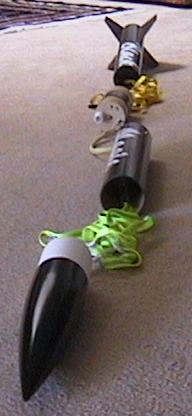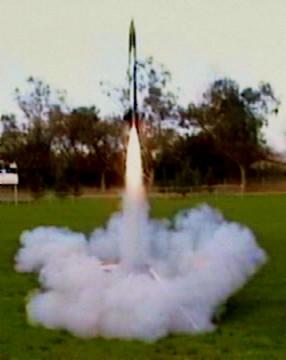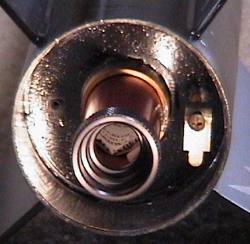Scratch Black Magic Original Design / Scratch Built
Scratch - Black Magic {Scratch}
Contributed by Kevin McLaughlin
| Manufacturer: | Scratch |
 Brief
Description:
Brief
Description:
This was my first attempt at a dual deployment rocket designed for 29mm H/P
RMS. The deployment of 'chutes is performed by a Blacksky dual channel timer.
Component Description:
Body tube material is 3.1" phenolic material. Nose cone is made from LOC
3.1". Fin material is 1/8" PVC plastic. Used 2 plywood centering
rings and a plywood bulkhead for top of exhaust cooling compartment. Shock cord
made of 12' nylon tubing with Quick Link attachments.
Construction/Finishing:
This was my first rocket made of phenolic materials. I ordered the materials
from Rocky Mountain Rocketry cut to size and slotted for fins. As mentioned, I
used 1/8" PVC plastic purchased as scrap from Tap Plastic for about $1 per
12" x 8" sheet. PVC is very easy to work with. To cut, you just score
and snap along a straight edge. To finish, sand lightly with 200 grit sand
paper and you are ready to prime. PVC saves me a ton of time in constructing
both kits and scratch builds. PVC is not as tough as styrene, but due to weight
and fin location considerations, I thought is would be a better choice for this
project.
 The wad-less recovery
system incorporates a perforated motor tube, a cooling compartment between the
upper centering ring and a perforated bulkhead. I also use a steel exhaust
cooling mesh ala Aerotech that goes up the motor tube prior to RMS hardware.
The exhaust gasses pass through the steel mesh, through the perforated motor
tube into the cooling compartment and through the perforated bulkhead into the
recovery chamber. This system works very well, and I have used it successfully
in other rockets.
The wad-less recovery
system incorporates a perforated motor tube, a cooling compartment between the
upper centering ring and a perforated bulkhead. I also use a steel exhaust
cooling mesh ala Aerotech that goes up the motor tube prior to RMS hardware.
The exhaust gasses pass through the steel mesh, through the perforated motor
tube into the cooling compartment and through the perforated bulkhead into the
recovery chamber. This system works very well, and I have used it successfully
in other rockets.
Launch lugs are made from 5/16" brass tubing. Two 1" lengths are placed on each of the body tubes. These are glued and filleted in place with 5 min. epoxy. I used a ¼" x 7' launch rod for this rocket.
I painted this rocket using gloss black spray paint and applied the “Black Magic" decal split between the bottom and top body sections. No sealer was applied to this rocket, as I expect that it would get banged up a lot during trials. Black gloss spray is the most forgiving for performing repair/finish work, and sealers only impede the process.
I purchased the 3.1" LOC phenolic body tube, 29 mm motor mount tube, recovery hardware, centering rings and bulkhead from Rocky Mountain Rocketry. All hardware and finishing paint was purchased from my local Orchard Supply Hardware store. The Blacksky dual channel timer was purchased off of eBay. The decal was purchased from the DecalZone using their custom decal engine.
 Flight/Recovery:
Flight/Recovery:
I designed the 29mm motor mount to accommodate up to a 29 x 240 Doctor Rocket
hardware, but typically will be flying using Dr Rocket 180 29mm RMS. I built
into the base 3" ply centering ring two blind nuts that take #8 x
¾" brass machine screws. Window screen clips are used to for motor
retention.
The first flight was on an H-128 as pictured in this article using a Quick Burst Twiggy igniter. I used what I thought was a medium delay for the drogue. An Oxal e-match was used with a typical FFFG black powder ejection charge for a 29mm motor for the main chute programmed to deploy 25 seconds after launch. Rocket flight was very stable and straight at launch and acceleration to apogee. Estimated altitude per my wrasp calculations was around 1,100'.
Everything went wrong from here on: Ejection of drogue powered by the H-128 delay occurred 17 seconds after launch with the rocket already in a speedy ballistic trajectory. The drogue, a 24" nylon chute, shredded upon deployment and the rocket tumbled about 500 feet to the ground. Several searches of the near by woods were not successful, and I was thinking that my rocket was a goner.
 About an hour later,
I reviewed a video that I shot of the launch and was better able to triangulate
the crash area. I drove my car through the neighborhood looking for any signs
of my bird on roofs or lawns of the hapless inhabitants. I suddenly spotted my
rocket neatly placed on the sidewalk in front of a house. I pulled over to
inspect what was left, when a women approached me from the garage. I was
expecting a tongue lashing that would include comparing my irresponsible
behavior to that a teenager, or possibly even a terrorist given current world
events. To my pleasant surprise, the women's greeting indicated that the family
was model rocket friendly and were themselves hobbyist. To my relief she
described how the rocket had become tangled in one of her fruit trees and how
her children and her had brought it down. She even commented that my rocket was
a large one and pretty cool. After expressing much thanks and quickly exiting
the area, I drove home and inspected Black Magic more carefully. To my delight,
the only damage was to the paint finish of the nose cone.
About an hour later,
I reviewed a video that I shot of the launch and was better able to triangulate
the crash area. I drove my car through the neighborhood looking for any signs
of my bird on roofs or lawns of the hapless inhabitants. I suddenly spotted my
rocket neatly placed on the sidewalk in front of a house. I pulled over to
inspect what was left, when a women approached me from the garage. I was
expecting a tongue lashing that would include comparing my irresponsible
behavior to that a teenager, or possibly even a terrorist given current world
events. To my pleasant surprise, the women's greeting indicated that the family
was model rocket friendly and were themselves hobbyist. To my relief she
described how the rocket had become tangled in one of her fruit trees and how
her children and her had brought it down. She even commented that my rocket was
a large one and pretty cool. After expressing much thanks and quickly exiting
the area, I drove home and inspected Black Magic more carefully. To my delight,
the only damage was to the paint finish of the nose cone.
Lessons learned from my first attempt at dual deployment are as follows:
- Use a bright flag or other marker as a reminder to activate the timer or altimeter. You will never remember this in the course of prepping your rocket on the launch pad. I have also made this mistake with an altimeter that fortunately was not responsible for any deployment components. I have now learned this lesson.
- Always use two e-matches for both chutes and never rely on the motor delay alone for the drogue deployment. After researching what went wrong, I discovered that I had used a long delay instead of a medium delay- thus the 17 second drogue deployment.
 Summary:
Summary:
I liked working with the phenolic material, and am impressed with the
sturdiness of Black Magic. Had this bird been made of paper tubing, it would
have been in much worse shape. I noticed that one end of the tubing had done a
“core sample" landing based on the mud streaks on the finish. The
phenolic didn't have a scratch or wrinkle to show for it. Phenolic is heavy,
and I'm sure a 3.1" x 54" rocket would weigh in easily 30% less. Once
you get all the pieces cut to size, 5 minute epoxy glues everything together
nicely. Sanding and finishing is also a breeze with this material.
Phenolic material used for both body and engine tubes is tough to cut, but otherwise easy to work with. It takes to epoxy and sands well. I used an Exacto saw to cut the phenolic with good results. I had no problem finishing this rocket with primer followed by the black gloss finish.
Sponsored Ads
 |
 |











